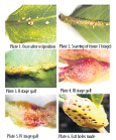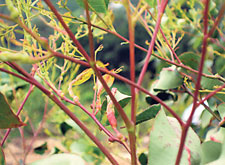Eucalyptus, those stately giants of the hill country slopes introduced to Sri Lanka as a forest plantation species, along with teak and mahogany, have had a controversial reputation. Though found to be useful for "railway sleepers" and industrial timber,they were severely opposed because of their adverse effects on soil fertility, hydrology and biodiversity.
Now comes a new cause for concern with a fast spreading invasive pest attack affecting areas of Eucalyptus in the hill country.
 |
| Different stages of
the Gall Wasp attack |
The Forest Research Centre in Badulla was alerted to the problem in early May. Researcher Dr. K.M.A. Bandara studied some trees in Passara and found the bug, which was sent to entomologist Dr. Wijesekera. “Up to now, only young trees that are about 5-6 metres in height have been infested,” say Dr. Bandara. Removing the insect from the trees is recommended for now but will not be possible if the disease spreads.
When attacked, the leaves of the infected Eucalyptus trees start developing abnormal bulbous swelling on the leaves or stems. These are called galls and are, in fact the plant's attempt to protect itself from an unusual occurrence. In this case the larvae of the insect after hatching out of eggs remain in a cavity formed within the plant tissues and feed on the tissues which results in formation of galls. The insect has been identified as a Eucalyptus Gall Wasp.
“This is the first time a Eucalyptus Gall Wasp has been reported in Sri Lanka,” says entomologist Dr. Anura Wijesekera. “But we are still at the early stages of our research and need a little time to carry out a comprehensive study to understand the nature of the new pest,” he says. According to Dr. Wijesekera, there can be several different species of Eucalyptus Gall Wasps and one species has been identified from Eucalyptus plantations in Lunugala, Koslanda and Ragala that were reported as infested.
Eucalyptus is native to Australia and it is believed the Gall Wasp too originated there.
Large scale attacks were first reported from northern and eastern Africa, the Middle East and Mediterranean countries, but the pest has spread like wild fire in every continent according to some reports, even in neighbouring India where it was first noticed in 2001 at Mandya district in Karnataka and later in 2002 at Marakkanam in Villupuram district of Tamil Nadu.
Dr. Wijesekara says we still do not have enough information on how this invasive species came to Sri Lanka. However, in recent years there have been several insect attacks - first it was the uncontrollable Mealy bug invasion on Araliya trees and more recently the insect attack causing leaf wilt disease in coconut trees in the Southern region.
The global fight against the Gall Wasp has had a breakthrough with Israel finding a natural predator that could be used to control this pest biologically.
Last week it was reported that Israel would help India to introduce this biological control. Whether this is the answer for Sri Lanka is not known but action must be taken quickly to fight the pest.
What’s being done
 |
| A tree under attack by the Gall Wasp in Passara. Pic by Dr. K.M. A. Bandara |
“The situation is still not alarming, but we are aware of it and will take steps to stop the pest spreading with the support of all the relevant parties,” said Conservator General of Forests Anura Satharasinghe.
As the first step, the Forest Department has requested the technical support of entomologists and conducted two workshops for managers of Eucalyptus plantations in Badulla and Nuwara Eliya on how to identify the symptoms of Gall Wasp infestation.
Plans are being made to set up a ministerial committee with experts in the field to discuss the actions to be taken.
Eucalyptus: The good and the bad
Love them or hate them, Eucalyptus trees play an important part in forestation in Sri Lanka. Native to Australia, the Eucalyptus was introduced to Ceylon in the latter part of the 8th century by planters who had links with Australia.
A more organized attempt was made by the Botanic Gardens staff who obtained 50 Eucalyptus seeds in 1880 - most of these were sent to Hakgala Botanical Gardens where a plantation was cultivated in 1882. Some 20 of these still survive in Hakgala Gardens and are now enormous.
Eucalyptus like any other fast growing tree sucks up water from the soil rapidly and there is a danger of the substrate drying up. Like other analogous trees, Eucalyptus forests are very poor in biodiversity, compared to forests with native trees.
But on the plus side, they grow quickly, meeting the country’s timber needs. Eucalyptus is now planted in Sri Lanka to meet the requirements of sawn timber, railway sleepers, transmission poles and fuelwood. It is also used for producing paper pulp. Eucalyptus oil has pharmaceutical, antiseptic, repellent, flavouring, fragrance and industrial uses.
Eucalyptus is also used as a windbreak. The establishment of trees on the patana grasslands in the upcountry began in the 1930's with planting of eucalyptus in compact blocks on the crests of ridges and hill tops as windbreaks.
Forest Department highlights these windbreaks have helped to protect villages from strong winds.
The Forest Department at present owns about 12,000 hectares of Eucalyptus plantations and a large extent is under privately owned estates.
According to 1991 statistics of the Forest Department, Eucalyptus cover was 29,600 hectares. Prof. J. Costa of University of Peradeniya at a recent seminar on Carbon stocks and Carbon Sequestration revealed the plantation forests including Eucalyptus, Pinus and Teak etc absorb about 5% of Sri Lanka’s total carbon emissions. |



